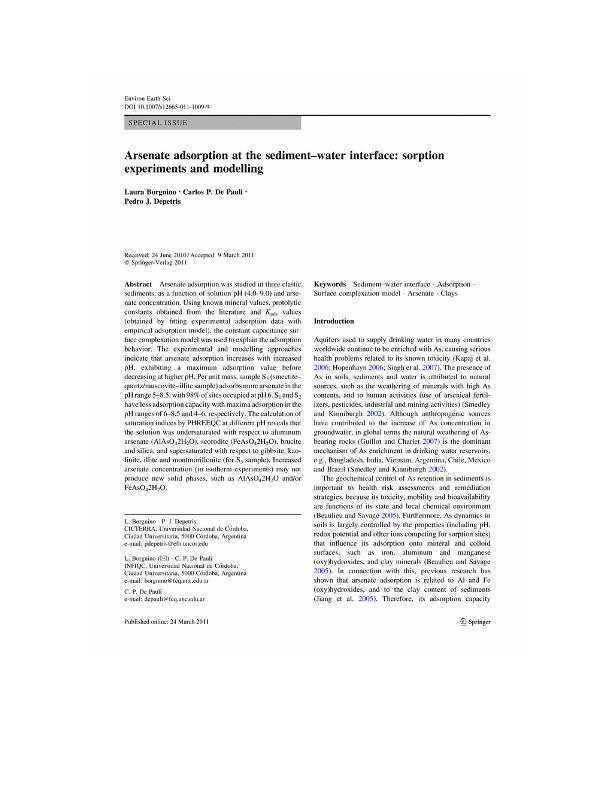Artículo
Arsenate adsorption at the sediment-water interface: Sorption experiments and modelling
Fecha de publicación:
01/2012
Editorial:
Springer
Revista:
Environmental Earth Sciences
ISSN:
1866-6299
Idioma:
Inglés
Tipo de recurso:
Artículo publicado
Clasificación temática:
Resumen
Arsenate adsorption was studied in three clastic sediments, as a function of solution pH (4.0-9.0) and arsenate concentration. Using known mineral values, protolytic constants obtained from the literature and K ads values (obtained by fitting experimental adsorption data with empirical adsorption model), the constant capacitance surface complexation model was used to explain the adsorption behavior. The experimental and modelling approaches indicate that arsenate adsorption increases with increased pH, exhibiting a maximum adsorption value before decreasing at higher pH. Per unit mass, sample S 3 (smectite-quartz/muscovite-illite sample) adsorbs more arsenate in the pH range 5-8. 5, with 98% of sites occupied at pH 6. S 1 and S 2 have less adsorption capacity with maxima adsorption in the pH ranges of 6-8.5 and 4-6, respectively. The calculation of saturation indices by PHREEQC at different pH reveals that the solution was undersaturated with respect to aluminum arsenate (AlAsO 42H 2O), scorodite (FeAsO 42H 2O), brucite and silica, and supersaturated with respect to gibbsite, kaolinite, illite and montmorillonite (for S 3 sample). Increased arsenate concentration (in isotherm experiments) may not produce new solid phases, such as AlAsO 42H 2O and/or FeAsO 42H 2O. © 2011 Springer-Verlag.
Archivos asociados
Licencia
Identificadores
Colecciones
Articulos(INFIQC)
Articulos de INST.DE INVESTIGACIONES EN FISICO- QUIMICA DE CORDOBA
Articulos de INST.DE INVESTIGACIONES EN FISICO- QUIMICA DE CORDOBA
Citación
Borgnino Bianchi, Laura Carolina; de Pauli, Carlos Primo; Depetris Gallino, Pedro Jose; Arsenate adsorption at the sediment-water interface: Sorption experiments and modelling; Springer; Environmental Earth Sciences; 65; 2; 1-2012; 441-451
Compartir
Altmétricas




